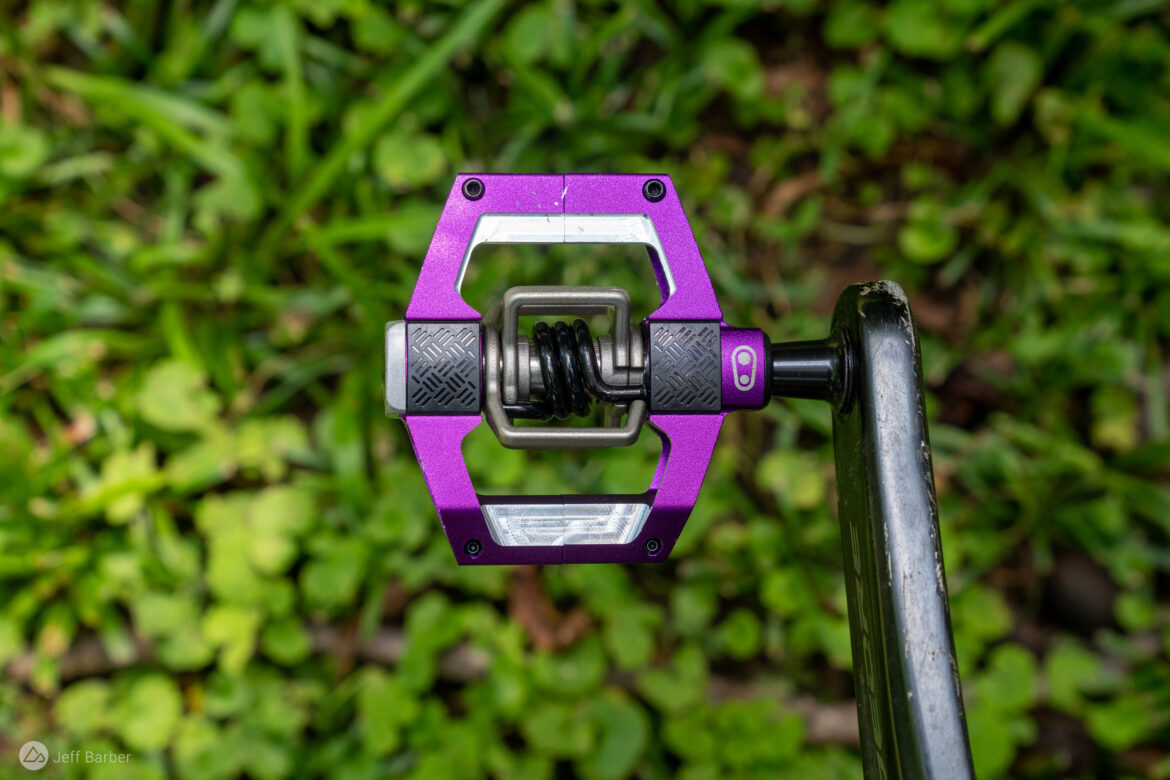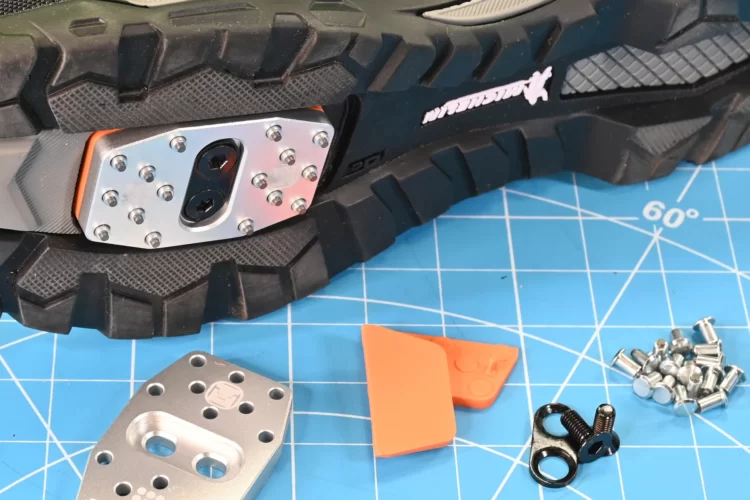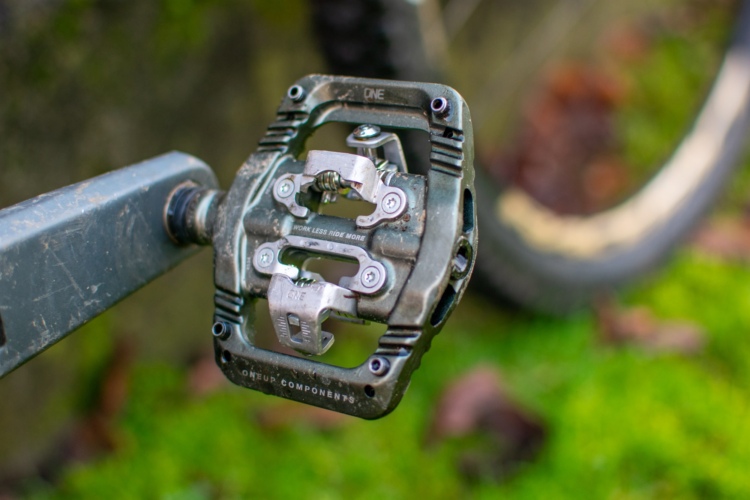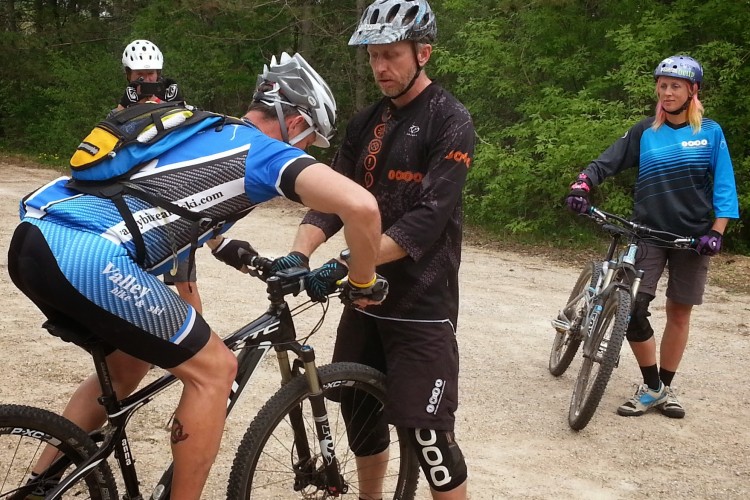
On the surface, pedals on a mountain bike might not seem very important. They are small and seemingly insignificant. But the truth is, pedals are a very important facet of having a bike that fits you, and the difference between a quality pedal and one that doesn’t work very well for the type of riding you are doing can make or break the experience.
Singletracks has tested dozens of the best mountain bike pedals, both clipless and flats, and these are some of our favorites.
Recommended clipless MTB pedals
A good set of clipless mountain bike pedals should be easy to clip in and out, while also keeping feet securely attached to the pedals. For a full rundown of all the things we look for in the best clipless pedals, scroll down to the pedal buyers guide below.

1. Shimano XTR M9120
The Shimano XTR line always represents a combination of light weight, performance, and durability. Compared to the M9100, the M9120 is more of a trail pedal with a larger platform for extra stability. They tend to be a pricier option, but the XTRs have proven long lasting with minimal maintenance. Adjusting the release tension is a snap using a hex key. Read the full review of the Shimano XTR pedals.
- Price: $190
- Buy from REI.

2. Crankbrothers Mallet E / Trail
Crankbrothers offers several Mallet clipless pedal options so riders can choose the one that works best for their riding style. The Mallet E pedals offer the largest platform while the Mallet Trails dial things down a bit for lighter weight. The pedals shed mud well though the clip-in tension is not adjustable. Get more details and read the full Crankbrothers Mallet Trail pedal review.
- Price: $179.99
- Buy from Crankbrothers.

3. Nukeproof Horizon CS
The Nukeproof Horizon SPD pedals feature a nice platform with four pins per side for grip even when you’re not fully clipped in. With a low profile and a clear focus on durability we would recommend these to friends who are on a tighter budget. For just over $100 you get all the benefit of the market’s best pedals, in the color of your choice, with seemingly long service intervals.
- Price: $101.99
- Buy from Wiggle

4. Hope Union TC
The Hope Union TC pedal has a dual clip mechanism where both sides of the retention system flex for easy engagement, though note that it uses proprietary cleats so cleats from other brands won’t work with the pedal. Hope offers two cleat options: a 4°/ 5° float and a 12°/13° option. The pedals have a decent amount of adjustability within the cleat mechanism and there is room for the retention to be softer or more firm. Read our full review of the Hope Union TC clipless pedals.
- Price: $190
- Buy from Backcountry

5. Funn Mamba S
The Funn Mamba S clipless mountain bike pedals feature adjustable tension, are SPD-compatible, and have four pins per side. Buyers can choose from single-side entry or dual side, though we recommend spending the few extra bucks for the dual-side version. In muddy conditions the Mamba fairs well, thanks in part to its raised cleat attachment and broad holes in the body that allow softer mud to fall out easily.
- Price: $110 single-sided, $115 dual-sided, pictured.
- Buy from Amazon
The pedals above are the ones we recommend; check here to read about all the clipless mountain bike pedals we’ve tested.
Recommended flat MTB pedals
Many mountain bikers start on flat pedals, and these days many clipless riders are even switching back. While the pedals may appear simple, there’s a wide range in terms of quality and design so it’s important to pick a solid pair. These are the flat pedals we like best.

1. Chromag Scarab
When it comes to customizing pin placement, Chromag is king, and the Scarab is easily one of our favorite flat pedals tested. With 40 different spots to position pins per pedal, the Scarabs are a force to be reckoned with for flat shoes everywhere. We tested the alloy version though a composite version is also available.
- Price: $140
- Buy from JensonUSA and other online retailers.

2. Oneup composite flat pedal
Oneup offers their flat pedal in both alloy and nylon (composite) versions, and in our tests the nylon looks worse for the wear but kept spinning smooth. It’s got a shape that’s easy to get along with and the pin layout offers reliable grip even in sketchy conditions.
- Price: $59.99
- Buy from Amazon and other online retailers.

3. Crankbrothers Stamp
The Crankbrothers Stamp flat pedals are incredibly popular, and the brand offers them in two sizes (small and large) and at multiple price points that vary based on the pedal weight and quality of materials. The Stamp 3s should be a solid, middle choice for most riders.
- Price: $99
- Buy from Crankbrothers or compare prices

4. PNW Loam
PNW Components deliver a great value, and their alloy Loam pedals have a nice, simple design. The PNW Loam pedals feature sealed cartridge and roller bearings inside that are easily serviceable. With 22 pins per pedal these offer good grip without locking feet in too tightly.
- Price: $99
- Buy from PNW.

5. Deity Black Kat
The Deity Black Kat pedals are among the flattest and lightest weight pedals we’ve tested, though the tradeoff is they’re not the grippiest. The Black Kats offer a large platform, though just eight pins per side.
- Price: $114
- Buy from Jenson USA
Beyond the flat pedals we recommend here, we’ve tested plenty of other great flat pedal choices.
Mountain bike pedals buyers guide
So, how do you choose which pedals to buy? There are a few different decisions you’re going to need to make, so let’s start by walking through some of the pros and cons of each.
Flat vs. Clipless Pedals

Flat Pedals
When choosing a mountain bike pedal, the first thing you’ll want to decide is if you want platform (aka flat) or clipless pedals. The main advantages of platform pedals are:
- You don’t need special shoes to use them. Any sturdy pair of shoes with a flat bottom will work.
- It’s easy to bail off the bike if necessary (great for beginners, but also downhill/dirt jump/freeriders).
- Entry-level platform pedals are generally less expensive than entry level clipless pedals.
Flat pedals have come a long way in recent years. They are lighter, sleeker, and grippier than ever, and specially-designed shoes by brands like Five Ten make the experience even better (check out the mountain bike shoe buyers guide for more info on footwear options). Some people who ride flats claim that it’s just as stable as being clipped in.
In recent years, flat pedal technology has come a long way, with significant improvements in the pins and shape of flat pedals, and the grippiness of flat pedal-specific shoes. There’s never been a better time to purchase and ride flat pedals! Even if you have flats that you’ve owned for many years, now might be a great time to look into a flat pedal upgrade.
However, many people will turn to clipless pedals in search of a really solid foot-pedal attachment.

Clipless Pedals
Clipless mountain bike pedal systems feature a special cleat that is attached to a mountain bike-specific shoe to give the rider a true connection between foot and pedal. The rider clips into the pedal by stepping down and releases by twisting his heel to the side. It can take beginners a bit of practice to get used to clipless mountain bike pedals, but there are some advantages:
- Improved pedal efficiency, as energy is transferred throughout the pedal stroke.
- Improved handling on technical rides. Clipless pedals keep your feet attached to the bike on bumpy descents and make things like bunny-hopping much easier.
- Decreased size. Clipless pedals cut a smaller footprint than platform pedals and can make clearing rocks easier. They also tend to be lighter for a similar-quality pedal.
There are several competing standards in the clipless pedal market, and cleats may not be compatible from one standard to another. The major clipless pedal standards are SPD, Time, and CrankBrothers. At the moment, SPD is the most widely-used standard across many brands, but unless you plan to share bikes or need to outfit multiple rigs, this may not be a very important consideration.

Combo Pedals
Combination mountain bike pedals merge the advantages of both pedal types: a wide platform plus a clipping mechanism. There are two different styles. One type has a clip on one side and a platform on the other, and the other type has a clip integrated into the platform on both sides, so that each are accessible at the same time.
The main trade-off in choosing a combo pedal is that there is often a large weight penalty, and the clips may be a bit more difficult to engage than on a clipless-only pedal. One issue with many combo pedals that only have a clip on one side is that they tend to rotate so that the clip side is always pointing towards the ground, because it is the side that weighs more. This makes getting clipped in a little more cumbersome, which can be annoying out on the trail. But they are a great choice if you have a bike that you use for a wide variety of applications and sometimes want to be clipped in, but also want to be able to easily jump on with normal shoes (like a commuter bike).
Other Pedal Factors to Consider
No matter which type of pedal you’re looking for, you may want to consider these additional items:
- Pedal weight — While lighter is generally better, sometimes it comes with durability consequences. Do some research before automatically choosing the lightest option.
- Mud shedding abilities — Look for open spaces in the pedals where mud can be pushed out when you place your feet on the pedals. This also applies to snow.
- Adjustability — This is mostly important when looking at clipless pedals where you’ll want to consider things like pedal tension settings (the amount of force it takes to clip and unclip) and float (the degree to which you can rotate your foot when clipped in). Platform pedals may allow you to replace spike pins or even change up the colors on the pedal body. More adjustability is better.
- Durability — It’s a good idea to choose a solid pedal with smooth bearings that won’t require a ton of maintenance. Great mountain bike pedals will stand up to the abuse of multiple rock strikes and scratches year after year.
- Ease of maintenance — Some pedals can be easily rebuilt and parts swapped out, while if others break, you have to buy a whole new pedal.
For even more information about mountain bike pedals, don’t miss the Everything You Need to Know about Mountain Bike Pedals podcast.
Looking for even more mountain bike pedal info? Here’s the latest news.
























21 Comments
Apr 22, 2010
Does anyone know any exceptions to this rule?
Jul 7, 2011
May 24, 2011
Apr 22, 2010
Aug 28, 2012
Jan 31, 2012
May 24, 2011
Jul 13, 2016
And like CorePapaXC stated:" When I come to a section that I might need to put my foot down" I un clip and ride flat. This part is awesome for me because I also ride a ton of street on my MTB. Bunny hops, drops, jumps etc. are all more cozy on a flat pedal to me so being able to ride how I like without having to change the pedals out is great.
Apr 23, 2010
Apr 22, 2010
Its good to have a rebuildable pedal, just not one that requires it a couple times a year (eggbeater).
Apr 22, 2010
A little side note about pedals and things to look for when shelling out your hard earned dollars...
Warranty and rebuilability (did I just make that word up?) are also big factors in my book. It sure is nice to be able to keep your pedals spinning like new with a rebuild kit. Lots higher end pedals have some form of rebuild kit and if a rebuild won't fix the problem, a good warranty will always get them working again.
Apr 23, 2010
Jun 15, 2017
Apr 23, 2010
Jul 14, 2017
Apr 22, 2010
Jun 27, 2011
Oct 5, 2018
Feb 15, 2011
Apr 23, 2010
May 24, 2011
If you have any questions, just be sure to ask!